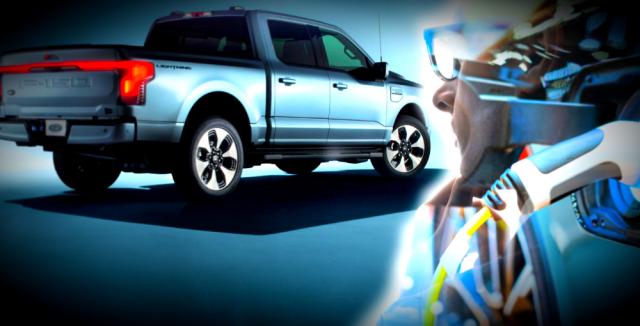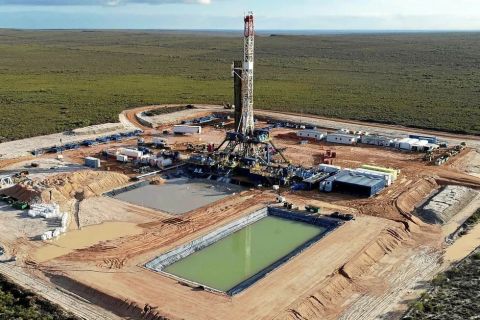
Historically, EVs have lacked an SUV/pickup that could compete with their gasoline counterparts on price and performance. Now comes the Ford F-150 Lightning. (Source: Shutterstock.com; Image silver Ford F-150 Lightning electric truck by Hypercar / Shutterstock.com)
This is an excerpt from the Ralph E. Davis Associates (RED) Weekly E&P Update Newsletter.
Electric vehicles (EVs) and their hybrid cousins have been a long time coming. It seems all of the automakers have dabbled in them at one time or another, and to varying degrees, but most had small production numbers and failed to generate a profit. Tesla finally reported an annual profit last year on the sales of about half a million EVs.
EVs are viewed as a “carbon free” transportation alternative because they don’t have any direct emissions. Of course, the power that supplies their batteries must be generated somewhere, and in most of the U.S., this is from a coal- or natural gas-fired power plant. Although oil demand can be reduced through the adoption of EVs, much of this reduction will lead to increased demand for natural gas (especially as it continues to gain market share from coal) while some will be met by sources with lower carbon emissions, such as wind, solar and nuclear. Another potential climate benefit of EVs is their carbon emissions can be shifted to stationary sources where technologies like underground sequestration of CO₂ can be deployed.
The growth of EVs has been noticeable, but they’re a long way from displacing gasoline-powered engines. Given a large number of SUVs and light trucks in the U.S. fleet, I’ve always believed that EVs would fail to make a significant dent in the U.S. auto market until they introduced an SUV/pickup that could compete with their gasoline counterparts on price and performance. Now comes the Ford F-150 Lightning.
By now, you’ve probably seen the dramatic television commercial for Ford’s EV pickup truck, which is expected to be in production next year: other automakers are about to launch their own versions too. It’s hard not to be impressed by the Lightning’s appearance, but I was (cynically) prepared for a $100,000 MSRP for a vehicle with low horsepower and torque. I took a look at some performance comparisons and was pretty surprised. Published numbers suggest a pricing comparable to the current F-150 models (the most popular vehicle in the U.S.) with equal or better horsepower and torque numbers. The big negative is still driving range, which is made worse by recharging time (plan on adding an hour to a trip over 300 miles with the standard battery).
We’ll have to see how consumers react once the Lightning hits the road, but early indications are there could be strong demand. In the first three weeks after their announcement, Ford has racked up over 100,000 pre-orders (at $100 each). Add this to the 250,000 pre-orders scored for its radically different Cybertruck and we may be witnessing the beginning of a significant jump in EV adoption rate.
About the Author:
Steve Hendrickson is the president of Ralph E. Davis Associates, an Opportune LLP company. Hendrickson has over 30 years of professional leadership experience in the energy industry with a proven track record of adding value through acquisitions, development and operations. In addition, he possesses extensive knowledge of petroleum economics, energy finance, reserves reporting and data management, and has deep expertise in reservoir engineering, production engineering and technical evaluations. Hendrickson is a licensed professional engineer in the state of Texas and holds an M.S. in Finance from the University of Houston and a B.S. in Chemical Engineering from The University of Texas at Austin. He recently served as a board member of the Society of Petroleum Evaluation Engineers and is a registered FINRA representative.
Recommended Reading
Marketed: BKV Chelsea 214 Well Package in Marcellus Shale
2024-04-18 - BKV Chelsea has retained EnergyNet for the sale of a 214 non-operated well package in Bradford, Lycoming, Sullivan, Susquehanna, Tioga and Wyoming counties, Pennsylvania.
Triangle Energy, JV Set to Drill in North Perth Basin
2024-04-18 - The Booth-1 prospect is planned to be the first well in the joint venture’s —Triangle Energy, Strike Energy and New Zealand Oil and Gas — upcoming drilling campaign.
PGS, TGS Merger Clears Norwegian Authorities, UK Still Reviewing
2024-04-17 - Energy data companies PGS and TGS said their merger has received approval by Norwegian authorities and remains under review by the U.K. Competition Market Authority.
Energy Systems Group, PacificWest Solutions to Merge
2024-04-17 - Energy Systems Group and PacificWest Solutions are expanding their infrastructure and energy services offerings with the merger of the two companies.
Chevron, Exxon in Dispute Over Hess Stake in Guyana Oil Block
2024-02-27 - Chevron’s $53 billion deal to buy Hess’ interests in the Stabroek Block offshore Guyana could be derailed as Exxon, CNOOC say they have first rights of refusal on the block’s interests.



